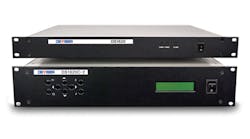This file type includes high resolution graphics and schematics when applicable.
Wireless communications networks have become essential tools for first-responders and a broad range of mission-critical state, local, and federal agencies. During emergency operations, an agency’s wireless network is simply too important to fail, or even suffer from degradation in performance and signal quality.
In the past, maintaining signaling reliability meant scheduling a technician with a handheld analyzer to search for interference and quality issues. However, with an increase in the distribution of small cells and wireless gateways, the traditional method of collecting on-site measurements has become logistically challenging, time-intensive, and costly.
Fortunately, there is a better way. By implementing a SpectrumPROFILER DS-1620S remote monitoring system from Deviser Instruments at key points throughout the wireless network infrastructure, an agency can monitor, analyzer, and resolve wireless interference signals in real time—and from anywhere in the world with internet access. The cloud-based DS-1620S (see figure) is engineered to quickly detect and identify licensed and unlicensed interference signals that have the potential to disrupt or impede wireless communications.
This remote monitoring system operates from 9 kHz to 3 GHz with 1-Hz frequency resolution; resolution bandwidths (RBWs) from 1 Hz to 3 MHz; and video bandwidths from 1 Hz to 1 MHz. It features the fast sweep speed needed to capture even sporadic interference, sweeping its entire bandwidth in only 60 ms. It is especially effective in capturing short-duration signals that appear over wide geographic areas.
The DS-1620S works through a network of distributed rack-mounted management units working in unison with an array of actively monitoring self-positioning sensors. The system is accessed through the internet via a simple-yet-powerful user-interface experience (UX) from any smartphone, tablet, or personal computer (PC). By offering network operators independence from specific locations and the flexibility to access their wireless spectrum at any time, system maintenance is simplified. A network operator can quickly resolve signal interference problems by activating the DS1620S’s manual search-and-resolve features or, alternately, enabling the system’s signal triangulation functionality.
The system is offered in a small-footprint 1U-high rack-mount enclosure. It can be remotely accessed using any computerized mobile communications device, laptop computer, or network operations center (NOC) computer via TCP/IP Ethernet over VPN or through an integrated web user interface. Remotely accessible features include measurement settings, such as center frequency, frequency span, reference level, amount of attenuation, preamplifier setting, sweep speed, and measurement type to be performed.
The analyzer can also measure channel power, occupied bandwidth (OBW) and adjacent channel leakage ratio (ACLR). It displays results in a number of different formats to simplify signal analysis, including in spectrograms three-dimensional (3D) waterfall displays, received-signal-strength-indication (RSSI) plots, and field strength displays.
Fully equipped, the DS-1620S can leverage an array of three or more geo-locating sensors that triangulate signals-of-interest, helping to precisely locate detected interference in three-dimensional (3D) space. The DS-1620S includes an impressive measurement tool, with a built-in 18-dB gain preamplifier, essential in capturing extremely low-level interference. The unit has a displayed average noise level (DANL) of -148 dBm offset 1 Hz from the carrier, without the preamplifier, and -158 dBm at the same offset with the preamplifier.
For measuring higher-level signals, the unit includes a step attenuator with 0 to 55 dB attenuation in 5-dB steps. The analyzer exhibits spectral purity of -95 dBc/Hz offset 10 kHz from the carrier. It holds frequency uncertainty to ±1 ppm, with frequency reference aging rate of ±1 ppm/year, and temperature drift of only ±1 ppm/°C for an operating temperature range of -10 to +55°C.
The system can operate in dual-modes as spectrum analyzer or as an interference analyzer, capturing 10 to 10,000 data points during a measurement cycle. It is equipped with 4 Gb of internal data memory, which can be easily upgraded to 100 Gb. Input RF connectors are female Type-N, and Universal Serial Bus (USB) and local-area-network (LAN) connectors are also included for network and computer connections.
Deviser Instruments, Inc., 780 Montague Expwy., Ste. 606, San Jose, CA 95131; (408) 955-0938
Looking for parts? Go to SourceESB.
This file type includes high resolution graphics and schematics when applicable.


